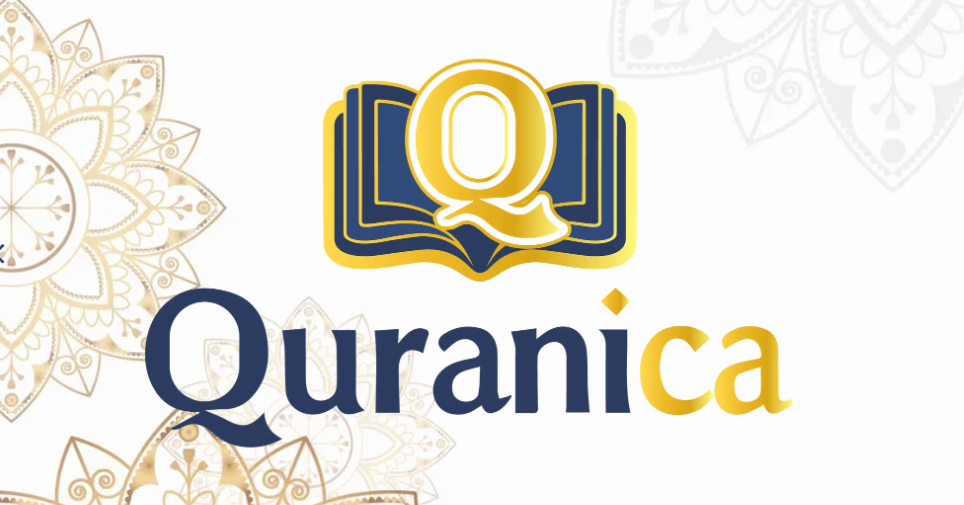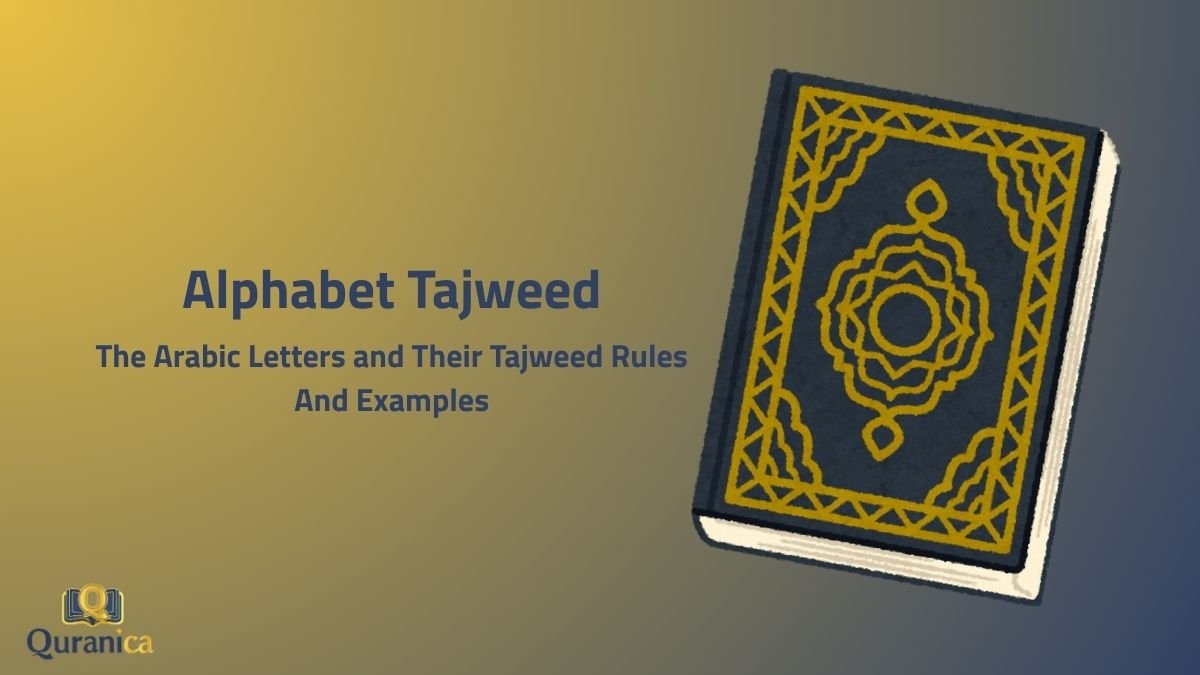The science of Tajweed in the Quran focuses on the correct pronunciation of its 29 Arabic letters by mastering their Makharij (points of articulation) and Sifat (distinctive traits).
Letters originate from five key areas—chest, throat, tongue, lips, and nose—and are shaped by traits that affect sound flow, strength, and tone. Mastery ensures correct meaning, avoids errors, and brings beauty and authenticity to recitation.
In our journey with the Quran, that foundation is the correct pronunciation of every single letter.
This isn’t just about recognizing shapes; it’s about mastering sounds as they were taught by the angel Jibril to our Prophet (peace be upon him). This is the core of Tajweed.
Join me as we explore the two pillars of perfect pronunciation: the precise point of articulation (Makhraj) and the unique characteristics (Sifat) of every letter in the Book of Allah.
What is the Quranic Alphabet Tajweed?
The Quranic alphabet Tajweed consists of the 29 letters that form the words of the Holy Quran. In the science of Tajweed, however, it’s about much more than simply recognizing these letters.
Tajweed ensures that we recite each letter with its precise sound and quality, exactly as it was revealed to our beloved Prophet Muhammad (peace be upon him).
The Importance of Correct Pronunciation in Quran (Why it matters)
Perfecting your pronunciation is a beautiful act of devotion, connecting your heart to the sacred sound of the revelation. It is both a spiritual pursuit and a linguistic necessity.
Proper articulation preserves the intended meaning of Allah’s words, fulfilling the right of the Quran to be recited correctly.
A small mistake can unintentionally change the meaning, as seen between ‘قلب’ and ‘كلب’.
“قَلْب” “Qalb” “Heart” This word, pronounced with the deep letter ‘ق’, refers to the heart.
“كَلْب” “Kalb” “Dog” This word, with the lighter ‘ك’, means dog, showing how a subtle shift can alter the meaning entirely.
Each Arabic Letter’s Tajweed, Makhraj, and Sifat
How to pronounce Arabic letters Tajweed? Here, we will journey through the alphabet one by one, discovering the unique home (Makhraj) and personality (Sifat) of each letter.
1. Hamzah (ء) Letter’s Tajweed, Makhraj, and Sifat
The Hamzah originates from the deepest part of the throat. It is the very beginning of the vocal tract, producing a sharp, clear stop of sound.
Its qualities include Jahr (audibility) and Shiddah (strength), which give it a distinct and abrupt sound.
“يُؤْمِنُونَ”
“Yu’minoon”
“They believe.” (Surah Al-Baqarah: 3)
Notice the clear stop and separation in the sound at the Hamzah, preventing it from slurring into the next letter.
2. Alif (ا) Letter’s Tajweed, Makhraj, and Sifat
The Alif of Madd (elongation) does not have a specific point of articulation like other letters. It originates from the empty space in the mouth and throat.
It is always saakin and preceded by a Fathah. The Alif itself has no Sifat but follows the preceding letter: if the letter before it is heavy, the Alif is pronounced heavily, and if it is light, the Alif is light.
“قَالَ”
“Qaala”
“He said.” (Surah Al-Baqarah: 30)
Here, the Alif elongates the heavy ‘ق’ (Qaaf), so the sound of the Alif is also heavy and full.
3. Baa (ب) Letter’s Tajweed, Makhraj, and Sifat
The letter Baa is born when the inner parts of the two lips press together firmly and then part. It is a simple and clear lip-letter.
It is a letter of Jahr (audibility), Shiddah (strength), and Istifal.
Most importantly, it possesses the unique quality of Qalqalah (vibration) when it is saakin.
“كَسَبَ”
“Kasaba”
“He earned.” (Surah Al-Baqarah: 281)
The articulation of ‘ب’ (Baa) here is clear and light, produced by the meeting of the lips.
4. Taa (ت) Letter’s Tajweed, Makhraj, and Sifat
The Taa emerges from the tip of the tongue when it touches the gums of the two upper front teeth, the same place as ‘ط’ and ‘د’.
Its defining feature is Hams (whisper), a clear release of breath. It also has Shiddah (strength) and Istifal.
“تَتْلُونَ”
“Tatloona”
“You recite.” (Surah Al-Baqarah: 44)
Listen for the soft whisper of air that accompanies the ‘ت’ (Taa), distinguishing it from the letter ‘د’ (Dal).
5. Thaa (ث) Letter’s Tajweed, Makhraj, and Sifat
The letter Thaa is produced when the tip of the tongue touches the bottom edge of the two upper front teeth, similar to the “th” sound in “three.”
It is a soft, breathy letter characterized by Hams (whisper) and Rikhawa (sound flow). It is also a light letter (Istifal).
“كَثِيرًا”
“Katheeran”
“Many.” (Surah Al-Baqarah: 109)
The sound of ‘ث’ (Thaa) is gentle and flows continuously with a whisper of air.
6. Jeem (ج) Letter’s Tajweed, Makhraj, and Sifat
The Jeem comes from the middle of the tongue rising to touch the roof of the mouth (the hard palate).
This letter has the qualities of Jahr (audibility) and Shiddah (strength). It is one of the five letters of Qalqalah (vibration).
“ٱلْفَجْرِ”
“Al-fajr”
“The dawn.” (Surah Al-Fajr: 1)
When the ‘ج’ (Jeem) is saakin, as it is here, it produces a clear echoing or bouncing sound.
7. Haa (ح) Letter’s Tajweed, Makhraj, and Sifat
The Haa is a unique throat letter, emerging from the middle of the throat. It produces a tense, breathy sound, with no vibration in the vocal cords.
It is defined by its quality of Hams (whisper), creating a significant flow of air. It also has Rikhawa (sound flow) and is an Istifalletter.
“ٱلرَّحْمَـٰنِ”
“Ar-Rahman”
“The Entirely Merciful.” (Surah Al-Fatihah: 3)
This letter requires a tightening in the middle of your throat to produce its distinct, breathy sound.
8. Khaa (خ) Letter’s Tajweed, Makhraj, and Sifat
The Khaa is the final throat letter, originating from the highest part of the throat, nearest to the mouth. It produces a raspy, gargling sound.
It has the quality of Hams (whisper) and Rikhawa (sound flow). Crucially, it is a heavy letter, characterized by Isti’la (elevation).
“خَلَقَ”
“Khalaqa”
“He created.” (Surah Al-‘Alaq: 2)
The sound of ‘خ’ (Khaa) is full and heavy, filling the mouth as the back of the tongue rises.
9. Daal (د) Letter’s Tajweed, Makhraj, and Sifat
The Daal is articulated from the tip of the tongue touching the gums of the upper front teeth, sharing its home with ‘ت’ and ‘ط’.
It is a letter of Jahr (audibility) and Shiddah (strength), making its sound strong and clear. It is also a letter of Qalqalah (vibration).
“أَحَدٌ”
“Ahad”
“The One.” (Surah Al-Ikhlas: 1)
When stopping on this word, the ‘د’ (Daal) at the end will have a clear bounce or echo.
10. Dhaal (ذ) Letter’s Tajweed, Makhraj, and Sifat
The Dhaal comes from the tip of the tongue touching the bottom edge of the upper front teeth, just like the ‘ث’. It sounds like the “th” in “this.”
It is distinguished by its qualities of Jahr (audibility) and Rikhawa (sound flow). It is a light letter (Istifal).
“ذَٰلِكَ”
“Dhaalika”
“That.” (Surah Al-Baqarah: 2)
The sound of ‘ذ’ (Dhaal) flows softly and has a noticeable vibration or buzz, unlike the whispered ‘ث’ (Thaa).
11. Raa (ر) Letter’s Tajweed, Makhraj, and Sifat
The Raa has a complex articulation, produced by the tip of the tongue tapping the hard palate, just behind the upper front gums.
Its Sifat include Jahr (audibility) and Tawassut (moderation in sound flow). It can be heavy (Tafkhim) or light (Tarqiq) depending on the vowels around it.
“رَبِّ”
“Rabb”
“Lord.” (Surah Al-Fatihah: 2)
Here, the ‘ر’ (Raa) is heavy because it has a Fathah, pronounced with a full mouth.
12. Zay (ز) Letter’s Tajweed, Makhraj, and Sifat
The Zay is articulated from the tip of the tongue pointing towards the area between the upper and lower front teeth, without touching them.
It is a letter of Jahr (audibility) and Rikhawa (sound flow). It has a very special quality called Safir (whistling), creating a distinct buzzing sound.
“أَنزَلَ”
“Anzala”
“He revealed.” (Surah Al-Baqarah: 4)
The ‘ز’ (Zay) has a sharp, clear buzzing or whistling sound that is unmistakable.
13. Seen (س) Letter’s Tajweed, Makhraj, and Sifat
The Seen shares the same point of articulation as Zay, with the tip of the tongue near the front teeth. It is the light counterpart of the letter ‘ص’.
It is defined by its strong Hams (whisper) and Rikhawa (sound flow). It also possesses the quality of Safir (whistling).
“ٱلنَّاسِ”
“An-naas”
“The mankind.” (Surah An-Nas: 1)
The ‘س’ (Seen) is a light, airy letter with a clear whistling sound and a noticeable flow of breath.
14. Sheen (ش) Letter’s Tajweed, Makhraj, and Sifat
The Sheen is produced from the middle of the tongue rising towards the hard palate, the same area as ‘ج’ (Jeem).
It has the qualities of Hams (whisper) and Rikhawa (sound flow). It also has a unique Sifah called Tafash-shi, which means the sound spreads widely in the mouth.
“شَرِّ”
“Sharri”
“The evil.” (Surah Al-Falaq: 2)
Notice how the sound of ‘ش’ (Sheen) is widespread and breathy, filling the mouth.
15. Saad (ص) Letter’s Tajweed, Makhraj, and Sifat
The Saad is the heavy counterpart of ‘س’ (Seen). It is articulated from the tip of the tongue near the front teeth, but with the back of the tongue rising.
It has Hams (whisper) and Rikhawa (sound flow). Its heaviness comes from Isti’la (elevation) and Itbaq (adhesion), and it also has Safir (whistling).
“ٱلصَّمَدُ”
“As-samad”
“The Eternal Refuge.” (Surah Al-Ikhlas: 2)
The ‘ص’ (Saad) is a full-mouthed, heavy whistling letter that sounds very different from the light ‘س’ (Seen).
16. Daad (ض) Letter’s Tajweed, Makhraj, and Sifat
The Daad is one of the most unique letters. It is produced from one or both sides of the tongue pressing against the upper back molars.
It is a letter of Jahr (audibility) and Rikhawa (sound flow). It is extremely heavy, with the qualities of Isti’la and Itbaq, and a unique Sifah called Istitalah (elongation of the sound).
“وَلَا ٱلضَّآلِّينَ”
“Wa la-ddaalleen”
“Nor of those who go astray.” (Surah Al-Fatihah: 7)
The sound of ‘ض’ (Daad) is deep, full, and spreads along the side of the tongue.
17. Ta’ (ط) Letter’s Tajweed, Makhraj, and Sifat
The Ta’ is the heaviest letter in the Arabic language. It shares the Makhraj of ‘ت’ and ‘د’—the tip of the tongue against the upper front gums.
Its power comes from its Sifat: Jahr (audibility), Shiddah (strength), Isti’la (elevation), and Itbaq (adhesion). It is also a letter of Qalqalah (vibration).
“ٱلصِّرَٰطَ”
“As-siraat”
“The path.” (Surah Al-Fatihah: 6)
The ‘ط’ (Taw) sound is incredibly full and resonant, with a sharp ending that bounces when saakin.
18. Dha (ظ) Letter’s Tajweed, Makhraj, and Sifat
The Dha is the heavy counterpart of ‘ذ’ (Dhaal). It is articulated from the tip of the tongue touching the bottom edge of the upper front teeth, with the back of the tongue raised.
It is a letter of Jahr (audibility) and Rikhawa (sound flow). Its heaviness comes from the qualities of Isti’la and Itbaq.
“ٱلۡعَظِيمُ”
“Al-A’dheem”
“The Most Great.” (Surah Al-Baqarah: 255)
The ‘ظ’ (Dha) is pronounced heavily, with the back of the tongue rising, creating a full-mouthed sound unlike the light ‘ذ’ (Dhaal).
19. ‘Ayn (ع) Letter’s Tajweed, Makhraj, and Sifat
The ‘Ayn is a deep and beautiful throat letter, emerging from the middle of the throat, the same place as ‘ح’ (Haa). It has a unique sound that feels like it’s being squeezed.
Its Sifat include Jahr (audibility) and Tawassut (a moderate flow of sound, between being stopped and flowing freely). It is a light letter (Istifal).
“نَعْبُدُ”
“Na’budu”
“We worship.” (Surah Al-Fatihah: 5)
The sound of ‘ع’ (‘Ayn) requires a distinct constriction in the middle of the throat to be pronounced correctly.
20. Ghayn (غ) Letter’s Tajweed, Makhraj, and Sifat
The Ghayn originates from the highest part of the throat and produces a distinct gargling sound.
It is a letter of Jahr (audibility) and Rikhawa (sound flow). Its defining characteristic is its heaviness, which comes from the quality of Isti’la.
“غَيْرِ”
“Ghayri”
“Not of.” (Surah Al-Fatihah: 7)
The ‘غ’ (Ghayn) has a full, gargling sound that resonates from the top of the throat.
21. Faa (ف) Letter’s Tajweed, Makhraj, and Sifat
The Faa is a simple lip letter. It is produced when the tips of the upper front teeth make contact with the inside of the lower lip.
It is a whispered letter, defined by its quality of Hams (whisper) and Rikhawa (sound flow). It is also a light letter (Istifal).
“فِي”
“Fee”
“In.” (Surah Al-Baqarah: 2)
A clear stream of air should be felt when pronouncing the ‘ف’ (Faa), making a soft “f” sound.
22. Qaaf (ق) Letter’s Tajweed, Makhraj, and Sifat
The Qaaf is a powerful letter that originates from the deepest part of the tongue rising to touch the soft palate at the back of the mouth.
It is a letter of Jahr (audibility) and Shiddah (strength). It is a very heavy letter (Isti’la) and one of the five letters of Qalqalah (vibration).
“قُلْ”
“Qul”
“Say.” (Surah Al-Ikhlas: 1)
The ‘ق’ (Qaaf) has a deep, full sound and produces a strong echo when it is saakin.
23. Kaaf (ك) Letter’s Tajweed, Makhraj, and Sifat
The Kaaf is the light counterpart of the Qaaf. It is articulated from the back of the tongue, but slightly forward of the Qaaf, where it meets the hard palate.
Its primary Sifat are Hams (whisper) and Shiddah (strength). The combination means the sound is first blocked, then released with a puff of air. It is a light letter (Istifal).
“لَكَ”
“Laka”
“To you.” (Surah Al-Kafirun: 6)
The ‘ك’ (Kaaf) is a light, crisp sound accompanied by a distinct puff of air, unlike the deep ‘ق’ (Qaaf).
24. Laam (ل) Letter’s Tajweed, Makhraj, and Sifat
The Laam is produced by the tip of the tongue touching the gums of the upper front teeth, from one side of the incisors to the other.
It is a letter of Jahr (audibility) and Tawassut (moderate sound flow). It is usually light, but becomes heavy (like in the name of Allah “ٱللَّهِ”) when preceded by a Fathah or Dammah.
“ٱلْحَمْدُ”
“Alhamdu”
“The praise.” (Surah Al-Fatihah: 2)
The ‘ل’ (Laam) here is light, with its sound flowing moderately without being cut off.
25. Meem (م) Letter’s Tajweed, Makhraj, and Sifat
The Meem is a simple lip letter, produced by closing the lips together. However, its sound resonates from the nasal passage.
It is a letter of Jahr (audibility) and Tawassut (moderate sound flow). It is also characterized by Ghunnah (nasalization), which is most prominent when it has a Shaddah.
“مَالِكِ”
“Maaliki”
“Master.” (Surah Al-Fatihah: 4)
The ‘م’ (Meem) is a clear sound produced by the lips with a corresponding nasal hum.
26. Noon (ن) Letter’s Tajweed, Makhraj, and Sifat
The Noon is articulated from the tip of the tongue touching the gums of the upper front teeth, similar to ‘ل’ (Laam). Like the Meem, it is a nasal letter.
It has the qualities of Jahr (audibility) and Tawassut (moderate sound flow). Its most defining feature is its inherent Ghunnah (nasalization).
“إِيَّاكَ نَعْبُدُ وَإِيَّاكَ نَسْتَعِينُ”
“Iyyaaka na’budu wa iyyaaka nasta’een”
“It is You we worship and You we ask for help.” (Surah Al-Fatihah: 5)
The sound of ‘ن’ (Noon) is produced from the tongue, but its resonance comes from the nose.
27. Haa’ (ه) Letter’s Tajweed, Makhraj, and Sifat
This is the lightest letter in the alphabet. It originates from the deepest part of the throat, the same place as Hamzah, but is pronounced without any tension.
It has the qualities of Hams (whisper) and Rikhawa (sound flow), making it a very soft and airy sound, like a sigh.
“هُوَ”
“Huwa”
“He.” (Surah Al-Ikhlas: 1)
The ‘ه’ (Haa’) is a gentle sound from deep in the chest, with a clear flow of air.
28. Waw (و) Letter’s Tajweed, Makhraj, and Sifat
The Waw has two different articulations. When it is a vowel, it is produced by rounding the lips. When it is a consonant, the lips are rounded but come closer together.
It is a letter of Jahr (audibility) and Rikhawa (sound flow). When it is saakin and preceded by a Fathah, it has the quality of Leen (softness).
“يَوْمِ”
“Yawmi”
“Day.” (Surah Al-Fatihah: 4)
The “aw” sound here is produced gently and softly, demonstrating the quality of Leen.
29. Yaa (ي) Letter’s Tajweed, Makhraj, and Sifat
Like the Waw, the Yaa has two articulations. As a consonant, it is produced from the middle of the tongue rising towards the hard palate. As a vowel, the sound is from the empty space in the mouth.
It is a letter of Jahr (audibility) and Rikhawa (sound flow). It also has the quality of Leen (softness) when saakin and preceded by a Fathah.
“عَلَيْهِمْ”
“Alayhim”
“Upon them.” (Surah Al-Fatihah: 7)
The “ay” sound is pronounced smoothly and without any difficulty, perfectly illustrating the Sifah of Leen.
Begin Your Perfect Recitation Journey with Quranica
Learning the Arabic alphabet with its Tajweed is the first step towards a profound connection with the Quran. It transforms your recitation from mere reading into a beautiful act of worship that pleases Allah SWT.
At Quranica, we are dedicated to helping you achieve this perfection. Our teachers are not just tutors; they are mentors on your spiritual journey.
- Our instructors are native Arabs and distinguished graduates of the prestigious Al-Azhar University.
- They hold the sacred Ijazah, an unbroken chain of transmission that links them directly to Prophet Muhammad (ﷺ), authorizing them to teach the Quran.
- With years of experience, they specialize in teaching non-native speakers, understanding your unique challenges and goals.
Quranica offers a wide spectrum of programs to meet you where you are on your journey:
- Learn Quran with Tajweed (for all levels)
- Quran Memorization (Hifz) Programs
- Ijazah Courses
- Islamic Studies
- Ten Qirat
Explore our full range of courses.

Conclusion
The Quranic alphabet in Tajweed comprises 29 letters, each requiring precise articulation and characteristics to maintain the integrity of Quranic recitation. Proper pronunciation ensures the preservation of meaning, as even slight errors can significantly alter words and their intent.
Tajweed depends on two pillars: Makharij al-Huruf (articulation points) and Sifat al-Huruf (letter qualities). The Makharij include five main areas—chest, throat, tongue, lips, and nasal passage—each responsible for different letter groups and sounds.
The Jawf produces long vowels, the throat yields six Halqiyyah letters, the tongue gives rise to the majority of Arabic letters with diverse articulation points, the lips form letters like Baa and Meem, and the nasal passage contributes the nasal resonance of Ghunnah in Noon and Meem.
The Sifat further distinguish similar letters with traits like Hams vs. Jahr, Shiddah vs. Rikhawa, and Isti’la vs. Istifal, influencing letter weight and clarity. Some letters also have unique characteristics such as Qalqalah (echo), Safir (whistle), and Tafash-shi (spreading).








0 Comments